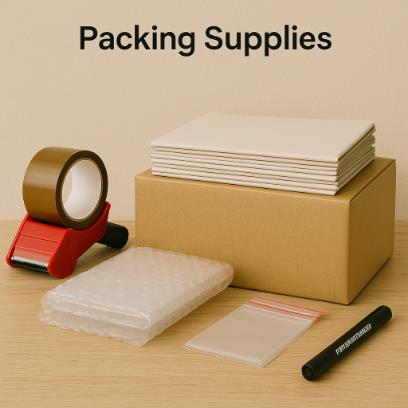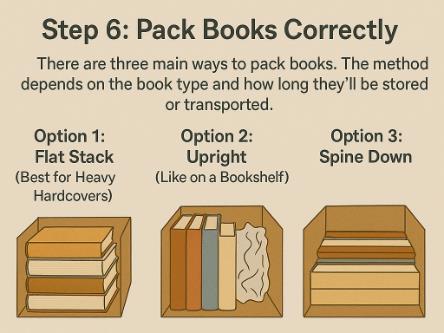Books are heavy, delicate, and often deeply sentimental. Packing them wrong can lead to torn covers, bent pages, snapped spines—or worse, a box bursting open mid-move. Whether you're shifting apartments or relocating interstate, how you pack your books makes all the difference.
Also, if you're moving a large personal library, antique collection, or simply don't want the hassle—it’s worth considering professional movers who know exactly how to handle books safely and efficiently.
In this guide, we tell you in detail so can safely move your books.
Books might seem easy to pack—just stack them in a box, right? Not quite. Here's what makes them challenging:
Weight adds up fast: A small box of hardcovers can weigh as much as 20–30kg.
Moisture and heat can ruin paper, covers, and glue bindings.
Improper stacking can cause bending, creasing, and spine damage.
Cramming too many books into a box can cause it to burst or make lifting dangerously heavy.
That’s why it’s important to be strategic.

Take a moment to list out your book collection before you begin packing—it helps you stay organised and track everything. Ask yourself:
Consider donating to local libraries, schools, or second-hand bookstores. Decluttering helps reduce moving costs and ensures you're only taking what truly matters.

Small, sturdy boxes are your best friend. Never overestimate how much weight books can add up to.
Ideal box types:
You can buy these from:

Here’s what you’ll need:
Skip plastic bags for book storage—they tend to hold in moisture, which can lead to mould and mildew damage.
Before loading any books, line the bottom of each box with a cushioning layer. Use:
This layer protects the books from any knocks and dampness from the base.

Books of different sizes stack poorly together. Sort your collection into:
This helps maintain uniform stacking, reducing the chance of bending or shifting during transit.

There are three main ways to pack books. The method depends on the book type and how long they’ll be stored or transported.
Lay books horizontally when packing—this keeps their spines straight and distributes weight more safely.
Place books upright, spines against the box wall. Fill gaps with paper so they don’t fall or bend.
You can lay books with the spines down and pages up, but never spine-up—it strains the binding.
Avoid packing books with pages facing down. It can warp them permanently.
Handle valuable or sentimental books—like first editions or personal journals—with extra care.
If you’re moving during monsoon or humid weather, moisture protection is non-negotiable.

Once your books are stacked, fill all remaining spaces with:
This prevents movement inside the box. Don’t forget to cushion the top of the box too, before sealing.
Use strong packing tape to seal the box in an H-pattern—down the middle and both edges. Then clearly label:
Use a red marker or “Fragile” tape if the box has antique or valuable books.
When it’s time to load the moving truck:
Packing and moving books might seem straightforward—until you try lifting five boxes in a row or realise your rare editions need special care.
Here’s why professionals can save your time, back, and book collection:
Experienced movers use book-specific packing techniques—whether it’s flat stacking, upright loading, or moisture protection. They also know how to avoid weight imbalance that leads to damage.
No flimsy boxes or duct-tape patch jobs here. Professional movers come equipped with:
Professional movers arrange boxes to make sure heavy ones—like those filled with books—don’t squash lighter, fragile items.
Books get heavy—fast. Lifting multiple book boxes increases the risk of back strain, especially on stairs or long carry distances. Movers are trained to handle this with safety gear and lifting techniques.
When you move things yourself, damage is your problem. But professional removalists often offer transit insurance, which can cover your books against loss, damage, or water exposure—especially helpful for valuable or rare collections.
Packing and moving books is time-consuming. Letting movers handle it frees you up to focus on other parts of the move—like settling into your new space or setting up your bookshelf exactly the way you like it.
Even seasoned movers mess up when it comes to books. Avoid these errors:
Packing too many books into a big box leads to disaster. Boxes collapse, movers struggle, and your back won’t thank you. Stick to small, strong boxes—even if it means using more of them.
Books hate humidity. One rainy moving day, and you could end up with warped pages and mouldy covers. Always line your boxes and wrap valuable books with care.
Even if the box isn’t full, check the weight. If it’s over 15–20 kg, it’s risky. Books are denser than you think. Go for balance, not volume.
Avoid tossing in chargers, mugs, or clothes just to fill the gaps. Books should travel with books. Mixing items can cause dents, bending, or worse—broken spines.
Label every box. Not just "Books"—but also where they go. This makes unpacking faster and prevents fragile books from getting mishandled.
Pack your favourites, journals, or books you’ll need in the first week separately. Mark it clearly and keep it close—you’ll thank yourself when the unpacking chaos begins.
Short on boxes? Suitcases with wheels are gold. They handle weight better and save your arms during the move.
Use apps like Sortly or Google Keep to log your collection. Take photos of spines if you don’t want to write them all down. Great for insurance or personal tracking.
If your books are going into storage instead of straight to your new home, here’s what you should do:
Books hate humidity. Long-term storage must be dry, dark, and well-ventilated.
Books are more than just paper and ink—they’re stories, memories, and lifelong companions. With the right prep and packing, you can ensure they arrive in perfect shape, no matter how far your move is.
From choosing the right box size to mastering the art of stacking and sealing, every step matters. So don’t leave it to guesswork—use this guide to pack your books like a pro.
And remember, the key isn’t to pack everything—it’s to pack wisely.
LOCATIONS & SUBURBS